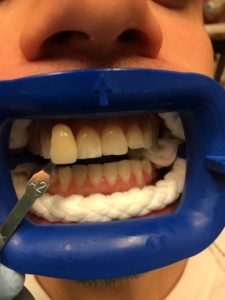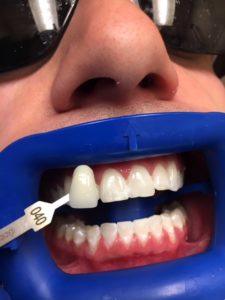Dental services in Manahawkin, NJ
Contact Us to make an appointment.
General Dentistry
We offer a wide range of dental services in Manahawkin, NJ, from routine checkups to extensive restorative and cosmetic procedures. We will present you with a comprehensive and suitable treatment plan to fit your dental needs.
Team Family Dental uses digital x-rays to provide a more comfortable way of capturing an image.
Why Digital X-rays are better.
The digital x-ray system is more sensitive than traditional x-ray systems. Your exposure to radiation is decreased by as much as 90%. The large, color-enhanced images let you see what your dentist sees, so it is easier for you to understand how your dentist will treat your teeth. It is also better for the environment as photo chemicals and film are no longer used.
The most advanced oral cancer screening system, Velscope, is here at Team Family Dental. When used in conjunction with a thorough soft tissue examination, your clinician will provide a complete oral cancer screening.
Cosmetic Dentistry
Cosmetic Dentistry allows a patient the opportunity to correct their smile and boost their self- confidence. From crooked teeth to a different shape, size, or color, cosmetic dentistry allows a variety of ways to address your concerns. The options available include porcelain crowns, veneers, bonding, implants and whitening.
It is critical that you take an active role in your smile design. Ask questions and understand the corrective limits of your procedure. Give us a call when you need dental services in Manahawkin, NJ.
Cosmetic dentistry offers many restorative materials other than silver amalgam. Ceramic materials provide strong, aesthetic, wear resistant restorations. Bonding can fill gaps between teeth and restores chipped and broken teeth.
Implants are the perfect solution for people with missing teeth. Dental implants are now an alternative to traditional (removable) bridges or dentures, because they anchor dentures, bridges and crowns firmly in place.
Before dental implants, we were limited in how we were able to replace missing teeth. Options included fixed bridges, which often required the reduction of adjacent teeth to replace a missing tooth, or removable dentures. Implant dentistry allows us to replace individual teeth, without altering adjacent natural teeth. Dental implants help retain jawbone and anchor dentures, bridges and crowns firmly in place!
A dental implant is a small “anchor.” It is inserted into the jawbone to take the place of your missing tooth root. A prosthetic replacement tooth is then secured to the top of the implant. Dental implants offer a more permanent solution for replacing lost teeth.
How do Dental Implants Work?
A dental implant is like an artificial tooth root that takes over the function of a real root. When a natural root is lost, it can be replaced with a dental implant. The implants are usually made of titanium. They are very durable and are well accepted by the human body. Dental implants are becoming a popular alternative to traditional, removable bridges and dentures. After dental implants are placed and the jawbone has healed, permanent teeth can be built on top of them. For example, a crown or bridge.
The Benefits of Dental Implants
More healthful & beautiful: When teeth are missing, the surrounding bone begins to shrink. This unhealthy bone loss can make your jaw line recede. Implant dentistry can help deterioration of the jawbone caused by loss of teeth, so your face retains its natural shape.
More Comfortable: Because dental implants are securely anchored, there is no slipping or movement as there is with dentures. This eliminates some of the key worries of dentures, including poor fit, gum irritation, and pain from exposed nerves.
More Confident: With dental implants, you will never need to cover your mouth when laughing, smiling, or speaking. You can eat your favorite foods without pain or fear of embarrassment. You will look better, feel better, and live more confidently.
A smile can make all the difference.
Invisalign clear aligners are specifically designed to give you the smile you want without any of the lifestyle changes you don’t.
No brackets to hide.
No restrictions on food or drinks.
No unexpected trips to the doctor due to broken wires or brackets.
Call Team Family Dental for a free Invisalign treatment consultation. Dr. Burg and Dr. Dennis are trained, Invisalign providers and can treat a wide range of teeth straightening cases with Invisalign clear aligners.
Let us transform your smile and join the more than 5 million patients who said “yes” to Invisalign treatment.
If you decide to choose all porcelain crowns for your restoration, you are choosing the most aesthetic, natural looking teeth available. They can hardly be distinguished from natural teeth. They are fabricated with the finest materials and the most sophisticated reproduction processes in the world.
Also known as laminates, they are thin shells that cover the front of the teeth.
What happens during the veneers restorative procedure?
In most cases, patients need three appointments for the entire procedure: diagnosis and treatment planning, preparation, and bonding.
Diagnosis and treatment planning: It’s critical that you take an active role in the smile design. Spend time in the decision-making and planning of your smile. Ask questions and understand the corrective limitations of the procedure. If necessary, have more than one consultation to feel comfortable that your dentist understands your objectives.
Preparation of teeth: This appointment will take from one to two hours. To prepare the teeth for your veneers your teeth are lightly buffed to allow for the small added thickness of the veneer. Usually, about a half a millimeter of the tooth is removed, which may require a local anesthetic. At this appointment, a mold is taken of the teeth, which is sent to a certified dental lab for the fabrication of the veneers. This should take no longer than two weeks for your new smile to be created. In most cases your dentist will fit you with a temporary smile during the fabrication of your new veneers.
Bonding of your veneers: This appointment will take about one or two hours. First, the dentist places the veneers with water or glycerin on the teeth to check their fit and get a true sense of their shade or color. While the veneers are resting on your teeth, make sure you view the aesthetic results and pay particular attention to the color. At this point, the color of the veneers can still be adjusted with the shade of the cement to be used.
The color cannot be altered after veneers are cemented. To apply your veneers, your teeth are cleaned with specific dental cleansers to achieve a firm and permanent bond. Then special cements are sandwiched between the veneer and tooth, a visible light beam initiates the release of a catalyst to harden the cement and your new smile is in place.


Unleash Your Brightness With Zoom In-Office Whitening!
We are happy to announce that Philips Zoom In-Office Whitening is now available at Team Family Dental. Over 4 million patients have whitened to a beautiful bright smile – why shouldn’t you be one of them!
Dr. Edward Burg & Dr. William Dennis have access to the most powerful professional strength products for whitening. They know more about your teeth & gums, your current state of health and the best ways to get the whitening results you are looking for.
About the Procedure
Your gums are carefully protected with a special covering, and then our unique hydrogen peroxide whitening gel is applied by your dental professional. Once on your teeth, hydrogen peroxide breaks down into stain-fighting radicals that break the molecular bonds making up stains, on and in your teeth. The intense light of the Philips Zoom WhiteSpeed Whitening LED Accelerator shining on our whitening gel helps these stain-fighting radicals whiten faster. The Accelrator light increases whitening results by an amazing 40%!
In only 60 minutes, Philips Zoom is proven to whiten your teeth up to 8 shades.
Periodontics
Periodontal treatment is necessary when various conditions affect the health of your gums and the regions of your jawbone that hold your teeth in place. Retaining your teeth is directly dependent on proper periodontal care and maintenance. Healthy gums enhance the appearance of your teeth, like a frame around a beautiful painting. When your gums become unhealthy, they can either recede or become swollen and red. In later stages, the supporting bone is destroyed and your teeth will shift, loosen, or fall out. These changes not only affect your ability to chew and speak. They also spoil your smile. Periodontal diseases are ongoing infections of the gums that gradually destroy the support of your natural teeth.
Adults over the age of 35 lose more teeth to gum diseases than from cavities. Three out of four adults are affected at some time in their life. The best way to prevent cavities and Periodontal Diseases is by daily thorough tooth brushing and flossing techniques and regular professional examinations and cleanings. Unfortunately, even with the most diligent home dental care, people still can develop some form of periodontal disease. Once this disease starts, professional intervention is necessary to prevent its progress.
Other important factors affecting the health of your gums include:
- Tobacco usage
- Diabetes
- Stress
- Clenching and grinding teeth
- Medication
- Poor nutrition
- Periodontal Disease & Tobacco
You are probably familiar with the links between tobacco use and lung disease, cancer, and heart disease.
Current studies have now linked periodontal disease with tobacco usage. These cases may be even more severe than those of non-users of tobacco. There is a greater incidence of calculus formation on teeth, deeper pockets between gums and teeth as well as greater loss of the bone and fibers that hold teeth in your mouth. In addition, your chance of developing oral cancer increases with the use of smokeless tobacco.
Individuals suffering from diabetes, especially uncontrolled diabetics, have a higher risk of developing bacterial infections of the mouth. These infections may impair your ability to process insulin, resulting in greater difficulty with controlling your diabetes. Periodontal diseases will be more severe than those of a non-diabetic and treatment more difficult. However, well-controlled diabetics have a lower incidence of cavities.
Surgical Procedures
One of the most common surgical procedures, incisions are made around the tooth, and the gum tissue is pulled back slightly. This provides access to thoroughly remove all plaque and calculus. Irregularities of the bone caused by the disease are smoothed over and the tissue placed at a higher level around the tooth, closer to the bone. When the procedure is completed, sutures are used. A protective dressing often is placed around the necks of the teeth to cover the surgical area and to help secure the new gum-to-tooth relationship. You will need to be seen in 7-10 days to remove any remaining sutures and evaluate your healing.
By moving the gum closer to the bone, the pockets will be reduced or eliminated. However, the tooth will appear longer and the spaces between the teeth will be larger. In cosmetic areas, other treatment options may be considered depending on how much gum tissue is exposed (“Smile Line”).
Sleep Apnea Appliances
How well do you sleep? Are you always tired? Do you snore?
We know – it’s a lot of questions! They are important ones. Sleep affects our lives more than people realize. It affects our mood, our mental health & especially our physical health. Research shows that sleep deprivation can cause depression, long term cardiovascular stress & a variety of other medical problems.
If you snore regularly and experience trouble sleeping, you may have a condition called Sleep Apnea.
What exactly is Sleep Apnea?
When the muscles that control the upper airway relax, some people begin to snore. When the airway becomes completely blocked and the person temporarily stops breathing, this is an episode of “obstructive apnea.” Each apnea event may last for a few seconds or up to a couple minutes or more. Events may happen frequently – even several hundred times a night.
Can this condition be treated?
There are many effective treatments for snoring. A widely accepted treatment is oral appliance therapy. An oral device custom fit by your dentist is designed to keep your airway open and help prevent apneas. The American Academy of Sleep Medicine recommends an oral appliance as a first-line treatment option for patients with mild to moderate obstructive sleep apnea, and also for those with severe obstructive sleep apnea who either decline or are unable to successfully use PAP therapy.
Take this short quiz to see your chances of a Sleep Apnea diagnosis – it’s called The Epworth Sleepiness Scale:
0 = Would Never Doze 2= Moderate Chance of Dozing
1= Slight Chance of Dozing 3= High Chance of Dozing
| Situation | Chance of Dozing |
|---|---|
| Sitting and Reading | ________ |
| Watching TV | ________ |
| Sitting, inactive in a public place | ________ |
| As a passenger in car for an hour with no break | ________ |
| Lying down in the afternoon when circumstances allow | ________ |
| Sitting and talking to someone | ________ |
| Sitting quietly after lunch without alcohol | ________ |
| In a car, while stopping for a few minutes in traffic | ________ |
The higher your score, the great chances of a Sleep Apnea diagnosis.
Discuss your results with our office at your next visit!

